
The Toshiba EMI Recordings / U.S. Edition Series
#24 The Early Beatles (AP-80034)
(Update: 21th. December 2024)

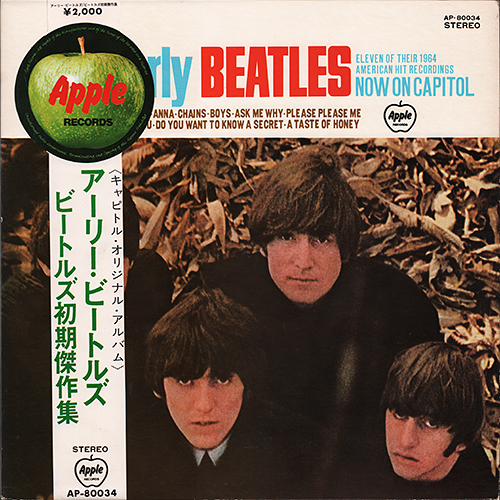 Apple 1st. Sleeve |
|
| TITLE | The Early
BEATLES |
||||
| CATALOG NUMBER | AP-80034 |
||||
| RELEASE DATE | 25th. September 1970 / First Press |
||||
| TRACK LISTING | SIDE 1 | SIDE 2 | |||
| Love Me Do (sim. stereo) |
Please Please Me |
||||
| Twist And Shout |
P. S. I Love You (sim. stereo) |
||||
| Anna |
Baby It's You |
||||
| Chains |
A Taste Of Honey |
||||
| Boys |
Do You Want To Know A Secret | ||||
| Ask Me Why | |||||
| FRONT --> Click! | BACK --> Click! | SIDE 1 --> Click! | SIDE 2 --> Click! | DISK | |
 |
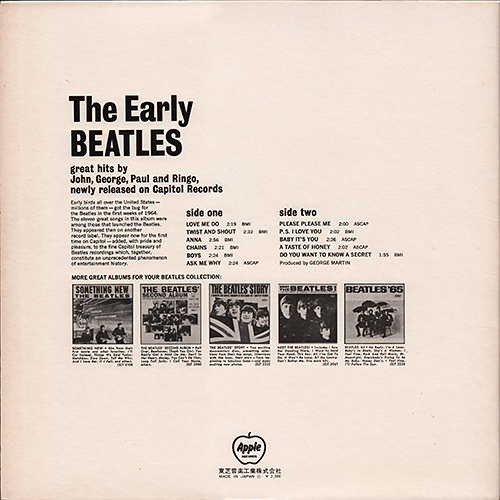 |
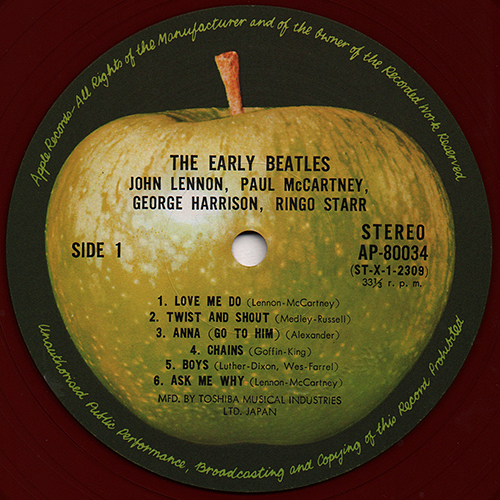 |
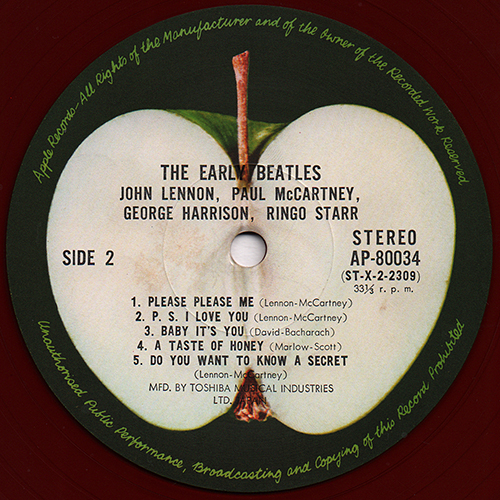 |
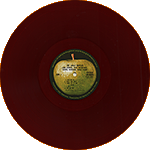 |
|
| INSIDE --> Click! | INNER SLEEVE | ||||
| FRONT --> Click! | BACK --> Click! | With Apple custom black inner sleeve. | |||
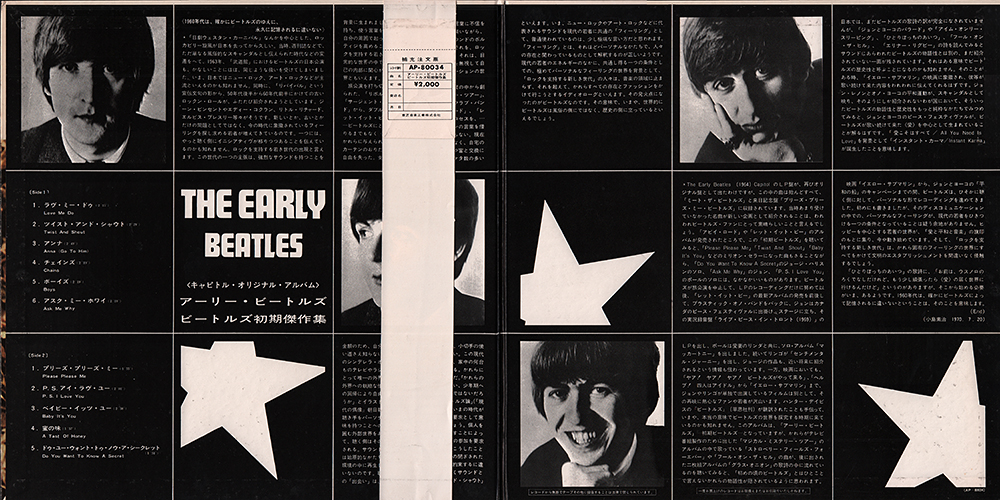 |
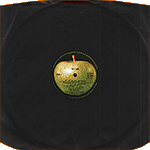 |
 |
|||
| LYRIC SHEET (Slip
Sheet Type) |
|||||
| FRONT --> Click! | BACK --> Click! | LYRIC SHEET CLOSE UP | |||
 |
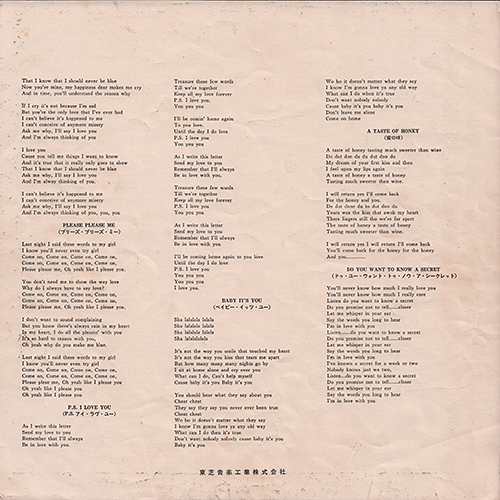 |
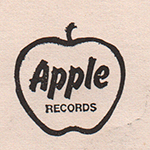 |
 |
||
 |
Company name "Toshiba Musical Industries Ltd." was printed on the lyric sheet. | ||||
| FRONT AND BACK COVER CLOSE UP | |||||
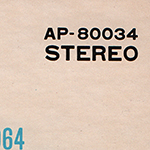 |
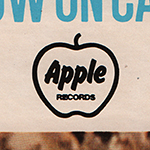 |
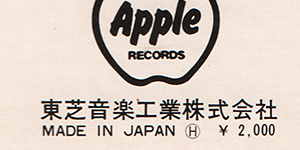 |
The Apple logomark was printed on the front and back
cover. "Toshiba Musical Industries Ltd." and "H ¥2,000" was printed at the bottomof the back cover. |
||
| INSIDE CLOSE UP | |||||
 |
Linernotes: Motoharu Kojima. |  |
Catalog number "AP-80034" was printed at the
lower bottom corner of the inside cover. |
||
| Apple Gourd in White OBI CLOSE UP | |||||
| OBI: FRONT --> Click! | OBI: BACK --> Click! | ||||
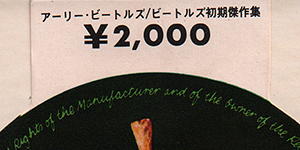 |
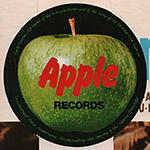 |
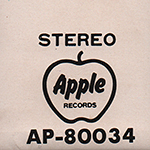 |
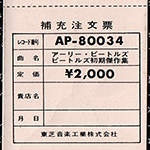 |
||
| Issued with a narrow Obi with a large round Apple logo at the top, has a white background. The word "STEREO" and Apple logo mark and catalog number "AP-80034" were printed on the front. 1st. pressing had a priced ¥2,000 on the obi strip. | Has a order sheet on the back side of the Obi. Catalog No, price "¥2,000" and "Toshiba Musical Industries Ltd."were printed at the order sheet. | ||||
| LABEL CLOSE UP | |||||
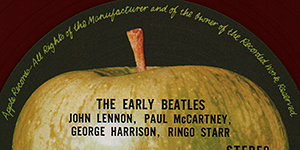 |
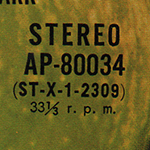 |
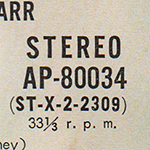 |
The phrase "Apple Records - All Rights of the Manufacturer and of the Owner of the Recorded work Reserved." was printed at the perimeter. | ||
| LABEL CLOSE UP | |||||
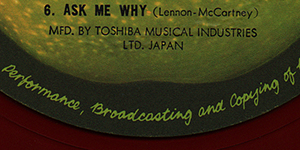 |
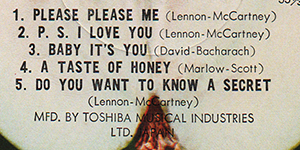 |
The words "MFD. BY TOSHIBA MUSICAL INDUSTRIES LTD. JAPAN" was printed at the bottom of the label. | |||
|
OTHER ITEM
|
|||||
| - | |||||
| RECORD LABEL | Dark Green Apple label Type-1 |
||||
| MIX | STEREO *excepted as noted |
||||
| MATRIX No. | SIDE 1 | ST-X-1-2309
1S 1 |
|||
| SIDE 2 | ST-X-2-2309
1S 4 |
||||
| PRESS MARK | 0M
-> 1C 1C |
||||
| VINYL COLOR | RED |
||||
| RECORD COMPANY'S NAME | SLEEVE | Toshiba
Ongaku kogyo Kabusikigaisha |
|||
| LABEL | MFD. BY
TOSHIBA MUSICAL INDUSTRIES LTD. JAPAN |
||||
| SYMBOL/PRICE | H - ¥2,000 |
||||
| LYRIC SHEET STYLE | Slip Sheet Type |
||||
| COVER FORM | Gatefold type. Hard cover. |
||||
| INNER SLEEVE |
Apple custom black sleeve |
||||
| OBI |
"Gourd" in white Obi (a narrow Obi with a
large round Apple logo at the top) / with Order sheet |
||||
| COVER DESIGN/ PHOTO/ NOTES | Front cover photo: Robert Freeman
taken in Hyde Park Liner notes: Motoharu Kojima |
||||
|
COMMENTS
|
Dark green Apple label
Type-1with black print. The Early Beatles is the Beatles' sixth album released on Capitol Records, and their eighth album for the American market. All of the tracks on this album had previously been issued on the early 1964 Vee-Jay Records release "Introducing... The Beatles". The front cover photo for this album features the same back cover photo for the British LP Beatles for Sale. In Novemver 1968, that was the date when Apple Corp Ltd. of England and Toshiba came to an agreement on the manufacturing and distribution of the Beatles' records in Japan. As part of that agreement, Toshiba had to reissue on the Apple label all the records previously issued on the Odeon label. The sleeves also had to be altered to desplay the Apple logo. Futher still, all the Odeon catalog number prefixes were changed to ones with Apple prefixes. In most cases, only the prefixes were changed and the catalog numbers were left intanct. Odeon singles, EPs, and LPs with the OR or OP prefixes were changed to Apple singles, EPs, and LPs with the AR or AP prefixes, respectively. But Toshiba did not instantly implement all these changes and did not immediately withdraw all Odeon label records. In fact, the phasing out of the Odeon label products and the phasing in of the Apple label was a lengthy process taking several months at least. The very first record in Japan issued under the Toshiba/Apple contract and bearing the Apple label was "The Beatles double LP (the White Album)", released on 21th. January 1969. And unlike elsewhere in the world, the first single in Japan to bear the Apple label was not "Hey Jude / Revolution" but rather "Ob- La-Di, Ob-La-Da / While My Guitar Gently Weeps", released on 10th. March, 1969. And in the Apple label, there are two subtypes, TOSHIBA MUSIC and TOSHIBA EMI. Further more, the early copies of the APPLE-TOSHIBA MUSIC type have dark Apple on its label, though the late copies have light one. Red vinyl: Besides good sound and quality printing, Japanese records also offered some other things of interest to the collector. One of the primary manufacturing companies in Japan, Toshiba, pressed a lot of their records on red, “Everclean” vinyl from 1958 through 1974 (maybe). While not pressed as collectors’ items, these red vinyl pressings are more sought out by collectors than their black vinyl counterparts. The Everclean vinyl was designed to be less prone to collecting static electricity and dust than the more common black vinyl. The obi: Apple "Gourd" in white Obi 1st. pressing issued with a narrow Obi with a large round Apple logo at the top, has a white background. The word "STEREO" and Apple logo mark and catalog number "AP-80034" were printed on the front. 1st. pressing had a priced ¥2,000 on rear sleeve and obi strip. While most Japanese records feature local music, a lot of music fans there like foreign music, as well. The language barrier in Japan presented a problem – should foreign album covers be changed for Japanese albums? The solution was the obi, which means “belt” or “sash”. The obi is a strip of paper, usually about two inches wide, that wraps vertically around the album cover, containing information about the artist and album in Japanese. As these strips of paper were fragile and easily torn, they are often missing, especially since consumers in the 1950s and 1960s attached little significance to them. Finding Japanese records made prior to 1970 that still have the obi intact can be quite difficult, and for some albums, nearly impossible. The inclusion of the obi can dramatically affect the price of some Japanese records, sometimes increasing the price by a factor of ten. |
||||
| TITLE | The Early
BEATLES |
||||
| CATALOG NUMBER | AP-80034 |
||||
| RELEASE DATE | 25th. September 1970 / First Press / CBS
SONY Contract Press |
||||
| TRACK LISTING | SIDE 1 | SIDE 2 | |||
| Love Me Do (sim. stereo) |
Please Please Me |
||||
| Twist And Shout |
P. S. I Love You (sim. stereo) |
||||
| Anna |
Baby It's You |
||||
| Chains |
A Taste Of Honey |
||||
| Boys |
Do You Want To Know A Secret | ||||
| Ask Me Why | |||||
| FRONT --> Click! | BACK --> Click! | SIDE 1 --> Click! | SIDE 2 --> Click! | DISK --> Click! | |
 |
 |
 |
 |
 |
|
| INSIDE --> Click! | INNER SLEEVE | ||||
| FRONT --> Click! | BACK --> Click! | With Apple custom black inner sleeve. | |||
 |
 |
 |
|||
| LYRIC SHEET (Slip
Sheet Type) |
|||||
| FRONT --> Click! | BACK --> Click! | LYRIC SHEET CLOSE UP | |||
 |
 |
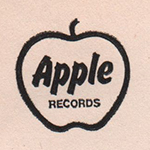 |
 |
||
 |
Company name "Toshiba Musical Industries Ltd." was printed on the lyric sheet. | ||||
| FRONT AND BACK COVER CLOSE UP | |||||
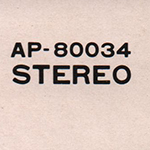 |
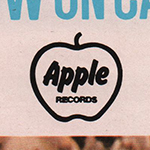 |
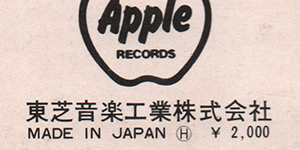 |
The Apple logomark was printed on the front and back
cover. "Toshiba Musical Industries Ltd." and "H ¥2,000" was printed at the bottomof the back cover. |
||
| INSIDE CLOSE UP | |||||
 |
 |
Linernotes: Motoharu Kojima. Catalog number "AP-80034" was printed at the lower bottom corner of the inside cover. |
|||
| Apple Gourd in White OBI CLOSE UP | |||||
| Sorry, I don't have
it. |
|||||
| Issued with a narrow Obi with a large round Apple logo at the top, has a white background. The word "STEREO" and Apple logo mark and catalog number "AP-80034" were printed on the front. 1st. pressing had a priced ¥2,000 on the obi strip. | Has a order sheet on the back side of the Obi. Catalog No, price "¥2,000" and "Toshiba Musical Industries Ltd."were printed at the order sheet. | ||||
| LABEL CLOSE UP | |||||
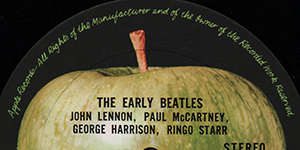 |
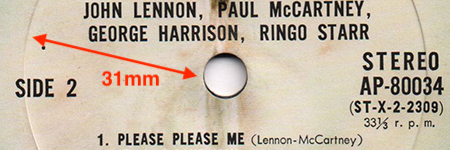 |
||||
| The phrase "Apple Records - All Rights of the Manufacturer and of the Owner of the Recorded work Reserved." was printed at the perimeter. | Sometimes
Toshiba had problems to press enough records to keep up with
the demand. To increase production they turned to other
companies (Gramophone, Sony etc.) to press up some copies of
a particular release. CBS Sony contract press: There is a ridge approximately 31mm out from the centre hole. |
||||
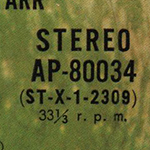 |
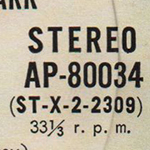 |
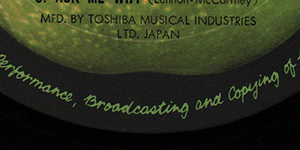 |
The words "MFD. BY TOSHIBA MUSICAL INDUSTRIES LTD. JAPAN" was printed at the bottom of the label. | ||
| LABEL CLOSE UP | |||||
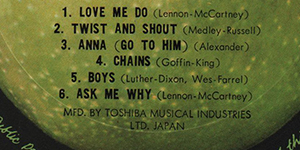 |
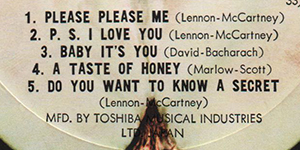 |
Dark green apple label. Slender font. |
|||
|
OTHER ITEM
|
|||||
| - | |||||
| RECORD LABEL | Dark Green Apple label Type-1 |
||||
| MIX | STEREO *excepted as noted |
||||
| MATRIX No. | SIDE 1 | ST-X-1-2309
1S 5 |
|||
| SIDE 2 | ST-X-2-2309
1S
8 |
||||
| PRESS MARK | F S 8 |
||||
| VINYL COLOR | BLACK |
||||
| RECORD COMPANY'S NAME | SLEEVE | Toshiba
Ongaku
kogyo Kabusikigaisha |
|||
| LABEL | MFD. BY
TOSHIBA MUSICAL INDUSTRIES LTD. JAPAN |
||||
| SYMBOL/PRICE | H - ¥2,000 |
||||
| LYRIC SHEET STYLE | Slip Sheet Type |
||||
| COVER FORM | Gatefold type. Hard cover. |
||||
| INNER SLEEVE |
Apple custom black sleeve |
||||
| OBI |
"Gourd" in white Obi (a narrow Obi with a
large round Apple logo at the top) / with Order sheet |
||||
| COVER DESIGN/ PHOTO/ NOTES | Front cover photo: Robert Freeman
taken
in Hyde Park Liner notes: Motoharu Kojima |
||||
|
COMMENTS
|
Dark green Apple label
Type-1with black print. The Early Beatles is the Beatles' sixth album released on Capitol Records, and their eighth album for the American market. All of the tracks on this album had previously been issued on the early 1964 Vee-Jay Records release "Introducing... The Beatles". The front cover photo for this album features the same back cover photo for the British LP Beatles for Sale. In Novemver 1968, that was the date when Apple Corp Ltd. of England and Toshiba came to an agreement on the manufacturing and distribution of the Beatles' records in Japan. As part of that agreement, Toshiba had to reissue on the Apple label all the records previously issued on the Odeon label. The sleeves also had to be altered to desplay the Apple logo. Futher still, all the Odeon catalog number prefixes were changed to ones with Apple prefixes. In most cases, only the prefixes were changed and the catalog numbers were left intanct. Odeon singles, EPs, and LPs with the OR or OP prefixes were changed to Apple singles, EPs, and LPs with the AR or AP prefixes, respectively. But Toshiba did not instantly implement all these changes and did not immediately withdraw all Odeon label records. In fact, the phasing out of the Odeon label products and the phasing in of the Apple label was a lengthy process taking several months at least. The very first record in Japan issued under the Toshiba/Apple contract and bearing the Apple label was "The Beatles double LP (the White Album)", released on 21th. January 1969. And unlike elsewhere in the world, the first single in Japan to bear the Apple label was not "Hey Jude / Revolution" but rather "Ob- La-Di, Ob-La-Da / While My Guitar Gently Weeps", released on 10th. March, 1969. And in the Apple label, there are two subtypes, TOSHIBA MUSIC and TOSHIBA EMI. Further more, the early copies of the APPLE-TOSHIBA MUSIC type have dark Apple on its label, though the late copies have light one. Sometimes Toshiba had problems to press enough records to keep up with the demand. To increase production they turned to other companies (Gramophone, Sony etc.) to press up some copies of a particular release. CBS Sony contract press: There is a ridge approximately 31mm out from the centre hole. The obi: Apple "Gourd" in white Obi 1st. pressing issued with a narrow Obi with a large round Apple logo at the top, has a white background. The word "STEREO" and Apple logo mark and catalog number "AP-80034" were printed on the front. 1st. pressing had a priced ¥2,000 on rear sleeve and obi strip. While most Japanese records feature local music, a lot of music fans there like foreign music, as well. The language barrier in Japan presented a problem – should foreign album covers be changed for Japanese albums? The solution was the obi, which means “belt” or “sash”. The obi is a strip of paper, usually about two inches wide, that wraps vertically around the album cover, containing information about the artist and album in Japanese. As these strips of paper were fragile and easily torn, they are often missing, especially since consumers in the 1950s and 1960s attached little significance to them. Finding Japanese records made prior to 1970 that still have the obi intact can be quite difficult, and for some albums, nearly impossible. The inclusion of the obi can dramatically affect the price of some Japanese records, sometimes increasing the price by a factor of ten. |
||||
| TITLE | The Early
BEATLES |
||||
| CATALOG NUMBER | AP-80034 |
||||
| RELEASE DATE | 1973? / Third Press |
||||
| TRACK LISTING | SIDE 1 | SIDE 2 | |||
| Love Me Do (sim. stereo) |
Please Please Me |
||||
| Twist And Shout |
P. S. I Love You (sim. stereo) |
||||
| Anna |
Baby It's You |
||||
| Chains |
A Taste Of Honey |
||||
| Boys |
Do You Want To Know A Secret | ||||
| Ask Me Why | |||||
| FRONT --> Click! | BACK --> Click! | SIDE 1 --> Click! | SIDE 2 --> Click! | DISK --> Click! | |
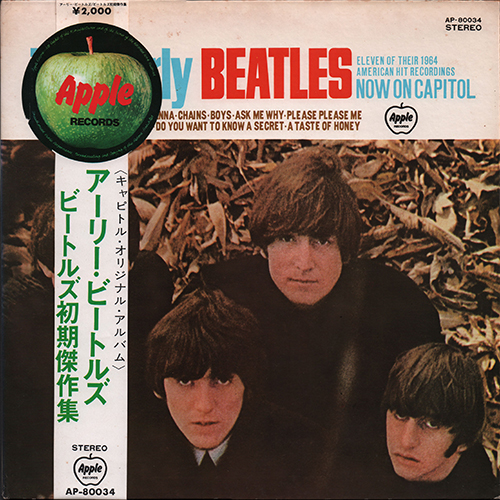 |
 |
 |
 |
 |
|
| INSIDE --> Click! | INNER SLEEVE | ||||
| FRONT --> Click! | BACK --> Click! | With Apple custom black inner sleeve. | |||
 |
 |
 |
|||
| LYRIC SHEET (Slip
Sheet Type) |
|||||
| FRONT --> Click! | BACK --> Click! | LYRIC SHEET CLOSE UP | |||
 |
 |
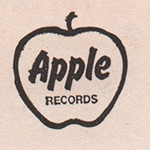 |
 |
||
 |
"Toshiba Musical Industries Ltd." was printed on the lyric sheet. | ||||
| FRONT AND BACK COVER CLOSE UP | |||||
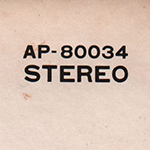 |
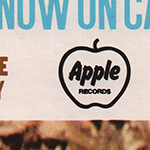 |
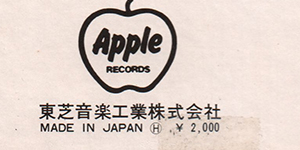 |
The Apple logomark was printed on the front and back
cover. "Toshiba Musical Industries Ltd." and "H ¥2,000" was printed at the bottomof the back cover. |
||
| INSIDE CLOSE UP | |||||
 |
 |
Linernotes: Motoharu Kojima. Catalog number "AP-80034" was printed at the lower bottom corner of the inside cover. |
|||
| Apple Gourd in White OBI CLOSE UP | |||||
| OBI: FRONT --> Click! | OBI: BACK --> Click! | ||||
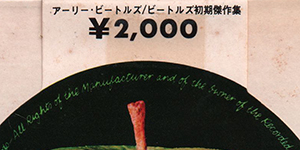 |
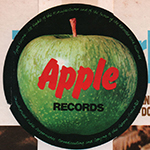 |
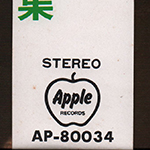 |
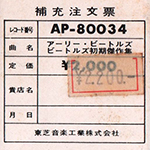 |
||
| Issued with a narrow Obi with a large round Apple logo at the top, has a white background. The word "STEREO" and Apple logo mark and catalog number "AP-80034" were printed on the front. 1st. pressing had a priced ¥2,000 on the obi strip. | Has a order sheet on the back side of the Obi. Catalog No, price "¥2,000" and "Toshiba Musical Industries Ltd."were printed at the order sheet. | ||||
| LABEL CLOSE UP | |||||
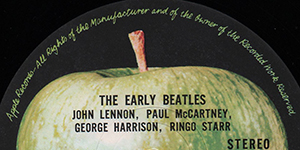 |
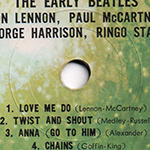 |
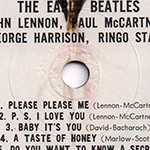 |
The phrase "Apple Records - All Rights of the Manufacturer and of the Owner of the Recorded work Reserved." was printed at the perimeter. | ||
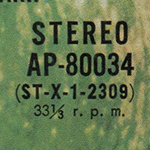 |
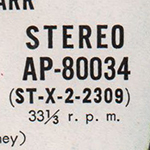 |
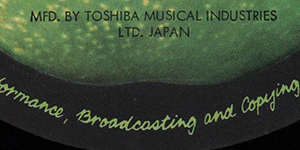 |
The words "MFD. BY TOSHIBA MUSICAL INDUSTRIES LTD. JAPAN" was printed at the bottom of the label. | ||
| LABEL CLOSE UP | |||||
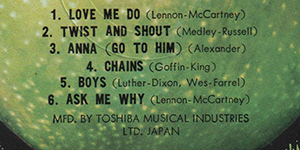 |
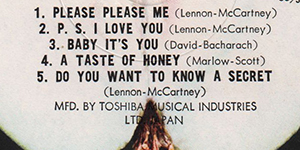 |
Light green apple label. Slender font. |
|||
|
OTHER ITEM
|
|||||
| - | |||||
| RECORD LABEL | Light Green Apple label Type-2-1 |
||||
| MIX | STEREO *excepted as noted |
||||
| MATRIX No. | SIDE 1 | ST-X-1-2309
1S 6 |
|||
| SIDE 2 | ST-X-2-2309
1S
7 |
||||
| PRESS MARK | 3BW |
||||
| VINYL COLOR | BLACK |
||||
| RECORD COMPANY'S NAME | SLEEVE | Toshiba
Ongaku
kogyo Kabusikigaisha |
|||
| LABEL | MFD. BY
TOSHIBA MUSICAL INDUSTRIES LTD. JAPAN |
||||
| SYMBOL/PRICE | H - ¥2,000 (Pasted ¥2,200 sticker) |
||||
| LYRIC SHEET STYLE | Slip Sheet Type |
||||
| COVER FORM | Gatefold type. Hard cover. |
||||
| INNER SLEEVE |
Apple custom black sleeve |
||||
| OBI |
"Gourd" in white Obi (a narrow Obi with a
large round Apple logo at the top) / with Order sheet |
||||
| COVER DESIGN/ PHOTO/ NOTES | Front cover photo: Robert Freeman
taken in Hyde Park Liner notes: Motoharu Kojima |
||||
|
COMMENTS
|
Light green Apple
label Type-2-1with black print. The Early Beatles is the Beatles' sixth album released on Capitol Records, and their eighth album for the American market. All of the tracks on this album had previously been issued on the early 1964 Vee-Jay Records release "Introducing... The Beatles". The front cover photo for this album features the same back cover photo for the British LP Beatles for Sale. In Novemver 1968, that was the date when Apple Corp Ltd. of England and Toshiba came to an agreement on the manufacturing and distribution of the Beatles' records in Japan. As part of that agreement, Toshiba had to reissue on the Apple label all the records previously issued on the Odeon label. The sleeves also had to be altered to desplay the Apple logo. Futher still, all the Odeon catalog number prefixes were changed to ones with Apple prefixes. In most cases, only the prefixes were changed and the catalog numbers were left intanct. Odeon singles, EPs, and LPs with the OR or OP prefixes were changed to Apple singles, EPs, and LPs with the AR or AP prefixes, respectively. But Toshiba did not instantly implement all these changes and did not immediately withdraw all Odeon label records. In fact, the phasing out of the Odeon label products and the phasing in of the Apple label was a lengthy process taking several months at least. The very first record in Japan issued under the Toshiba/Apple contract and bearing the Apple label was "The Beatles double LP (the White Album)", released on 21th. January 1969. And unlike elsewhere in the world, the first single in Japan to bear the Apple label was not "Hey Jude / Revolution" but rather "Ob- La-Di, Ob-La-Da / While My Guitar Gently Weeps", released on 10th. March, 1969. And in the Apple label, there are two subtypes, TOSHIBA MUSIC and TOSHIBA EMI. Further more, the early copies of the APPLE-TOSHIBA MUSIC type have dark Apple on its label, though the late copies have light one. The obi: Apple "Gourd" in white Obi 1st. pressing issued with a narrow Obi with a large round Apple logo at the top, has a white background. The word "STEREO" and Apple logo mark and catalog number "AP-80034" were printed on the front. 1st. pressing had a priced ¥2,000 on rear sleeve and obi strip. While most Japanese records feature local music, a lot of music fans there like foreign music, as well. The language barrier in Japan presented a problem – should foreign album covers be changed for Japanese albums? The solution was the obi, which means “belt” or “sash”. The obi is a strip of paper, usually about two inches wide, that wraps vertically around the album cover, containing information about the artist and album in Japanese. As these strips of paper were fragile and easily torn, they are often missing, especially since consumers in the 1950s and 1960s attached little significance to them. Finding Japanese records made prior to 1970 that still have the obi intact can be quite difficult, and for some albums, nearly impossible. The inclusion of the obi can dramatically affect the price of some Japanese records, sometimes increasing the price by a factor of ten. |
||||
